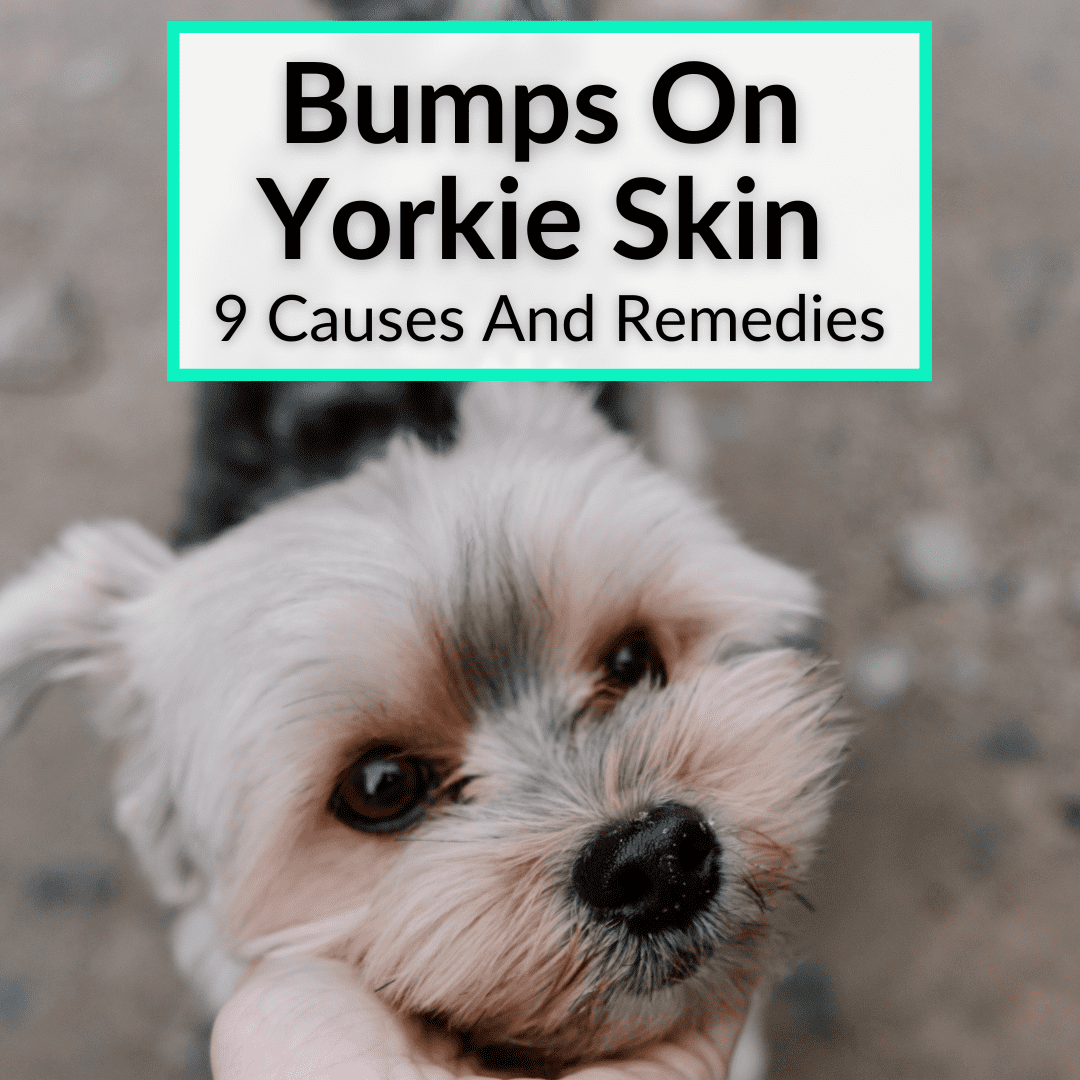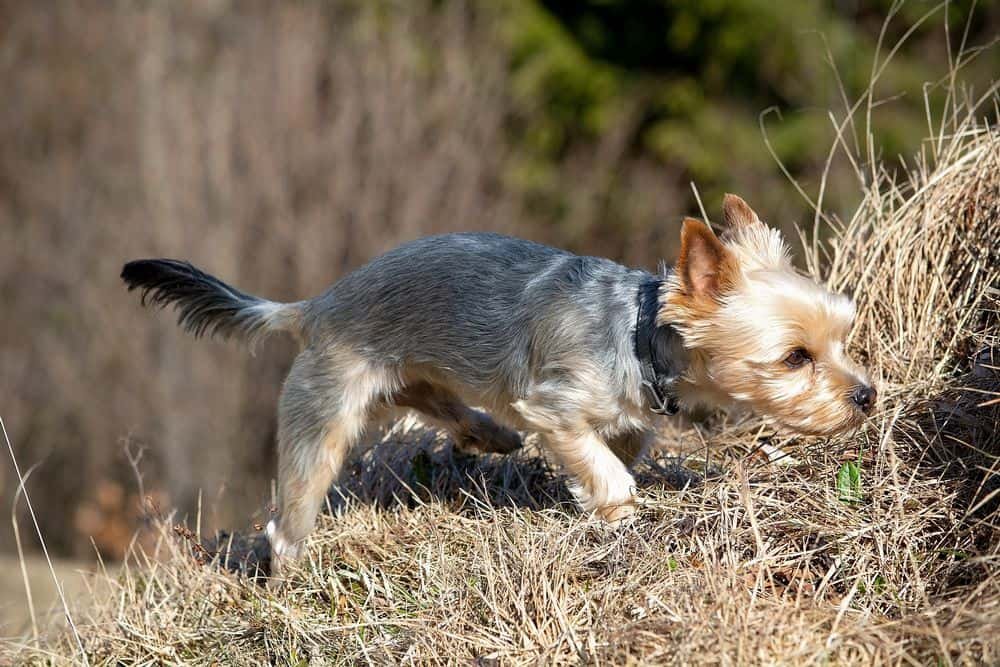
First of all, do not panic.
Most of the time, bumps on Yorkie skin are not serious and nothing to worry about.
But on rare occasions, they could be a symptom of a major issue.
We will help you tell the difference below. As always, your best bet is to consult a vet to be on the safe side.
Keep reading for a rundown of the 9 main causes of bumps on Yorkie skin, plus other symptoms of each cause. Those will help you identify what is causing the bumps on your Yorkshire terrier’s skin.
Contents
Bumps On Yorkie Skin
Bumps and lumps on a Yorkie’s skin can be attributed to folliculitis, warts, skin tags, abscesses, scabs, and tumors. Excessive scratching and chewing from allergies can also cause lumps and bumps on Yorkie skin.
If the bumps are swollen, oozing, or seem to be growing, please see a vet right away. Let’s take a look at the various possible causes of bumps on a Yorkie’s skin.
Folliculitis

If your Yorkie has red bumps on skin, ir could be folliculitis. This is a common skin condition in many dog breeds, including Yorkies.
Folliculitis occurs due to bacterial infection of hair follicles. Canine acne, dermatitis, and external parasites like fleas and ticks can also cause bacterial folliculitis.
In addition to bumps, other symptoms of folliculitis are swelling, redness, itching, hair loss, and pain in the affected region. Treatment includes the use of oral and topical antibiotics, creams, sprays, and shampoos.
Warts
Lumps and bumps due to warts usually occur in Yorkies with papillomavirus and generally appear around the dog’s mouth or on the paws. Typically, warts appear as a lump with a dot in the middle, although some warts could take on a cauliflower-like appearance.
Small-sized warts usually fall away on their own, However, in extreme cases, dogs might need surgery for their removal. Never ignore widespread canine warts, oozing warts, and warts that cause lameness or pain. Warts are highly contagious so please take care to isolate other dogs from the infected pet.
Skin Tags
Skin tags in Yorkies are common benign growths. They usually do not need any treatment and fall off on their own. Tags typically occur due to recurring trauma such as sleeping on hard surfaces, etc.
Canine skin tags are mostly firm and flat although some could be squishy and soft. They are typically seen on the bony parts of the dog’s body. If your Yorkie’s skin tag appears red, infected, or oozing, please see your vet right away.
Abscesses

An abscess is a pus-filled bump accompanied by redness, heat, and pain. The most common cause of an abscess is a bite from another creature, or a parasite such as a flea or tick or other insects. Infections can also cause abscess bumps in Yorkies.
Sometimes, abscesses can burst, releasing a foul-smelling liquid that oozes out. Severe abscesses need antibiotics for treatment.
Fatty Tumors
These lumps are common in middle-aged or senior Yorkies. An unspayed female Yorkie might also develop a bump on her belly, just under the ribs.
These types of tumors are usually benign and considered a normal part of canine aging. They are typically more common in obese dogs.
Blocked Oil Glands Or Sebaceous Cysts
These bumps typically appear similar to human acne. The common cause of sebaceous cysts is a clogged oil gland. Sebaceous cyst bumps can sometimes burst, releasing a pasty-white fluid. If the underlying cause is removed, the cyst will vanish. Some cysts need surgical removal.
Scabs
In Yorkies, scabs can occur due to impetigo, rashes, allergies, pyoderma, and bacterial or fungal infections. Depending on the cause of the scab, the signs and symptoms, as well as the treatment, will vary. Typically, scabs appear as crusty, brown papules.
Allergies

Yorkies do get allergies. They are sensitive dogs that often suffer from food allergies or allergies to environmental pollutants like grass, mold, and household cleaners.
Often, these allergies manifest as skin rashes that are rather itchy. If your dog scratches the rash, it could develop bumps and blisters.
Treatment includes the use of topical lotions or sprays to soothe the itch. You also need to make some dietary and lifestyle changes to prevent allergic reactions in your Yorkie.
Skin Cancer/Mast Cell Tumors
In rare cases, a bump could be due to skin cancer or mast cell tumors. Never ignore strange colored lumps and bumps on the lips. Some cancerous lumps are firm, raised, and wart-like while others may be rubbery. Please see your vet right away.
Bumps On Yorkshire Terrier Skin: Related Questions
Below, we will answer a few common questions related to bumps on a Yorkshire terrier’s skin. If you have any additional questions, please feel free to ask them in the comments below.
Do Yorkshire Terriers Get Lumps?
Yorkies that are not groomed properly could get lumps because of allergens trapped in their coat. A Yorkie with a long and flowing coat will need regular daily brushing. Without regular grooming, your pet’s coat can trap debris and allergens.
These make the skin itchy and scratching could result in lumps and bumps. Many Yorkie parents choose to keep their Yorkie’s coat short to prevent these issues and make grooming more manageable.

Certain dog breeds are more prone to lumps and bumps caused by to mast cell tumors (described above). These include Boxers, Labrador Retrievers, Schnauzers, and Beagles. Our Yorkshire Terriers are not on the list.
Also, dog breeds with wrinkled skin like Bulldogs and Shar Peis are highly susceptible to pyoderma and skin irritation due to the bacteria trapped in their skin folds.
What Foods Are Yorkshire Terriers Allergic To?
Common food allergies in Yorkies include food with proteins from dairy, beef, chicken, eggs, lamb, fish, soy, and wheat gluten.
Every time a Yorkie eats foods containing one or more of these allergens, its body produces antibodies that react with antigens, resulting in symptoms like vomiting, diarrhea, etc.
Some food allergies also manifest in the form of skin issues like itchy rashes which could develop into lumps and bumps when scratched.
If you suspect your Yorkie has a food allergy, please consult a vet specializing in canine allergies. You can also do food trial tests to determine which food is the culprit.
Yorkies with food allergies will need special hypoallergenic diets with hydrolyzed proteins or special prescription food or homemade meals. As always, make dietary changes slowly and always consult your vet before doing so. Allow the new diet at least 2 to 4 weeks to take effect.
Why Does My Yorkie Have Scabs?
Scabs on Yorkies could occur due to parasite bites (fleas/ticks/mites), bacterial or fungal skin issues, impetigo, pyoderma, and food or environmental allergens.
Do not allow your dog to scratch the scabs, because it could result in secondary infections. If needed, apply some hydrocortisone cream or a bit of coconut oil to help the scabs to fall off. Do not ignore widespread scabs, because they could indicate serious health issues.

What Does Folliculitis Look Like On Dogs?
Dogs with folliculitis will have swelling, redness, lumps, pustules/papules, itchy skin, hair loss, darkening of the skin, and crusting or scaling.
The common causes of canine folliculitis, which is the inflammation of hair follicles, are allergies, fungal infections, pyoderma, canine acne, lick-granuloma, immune system disorders, fleas or ticks, and Cushing’s disease.
Breeds like Westies, Wirehaired Fox Terriers, Labrador Retrievers, Golden Retrievers, Lhasa Apsos, and Shih Tzus are more prone to folliculitis stemming from allergies.
The treatment for folliculitis will vary based on the cause: bacterial folliculitis will need antibiotics (oral and topical) while fungal issues will need systemic antifungal medication, etc.
Yorkie Bumps On Skin: Final Thoughts
If your Yorkshire terrier has bumps on its skin, the first step is to figure out what caused them. Most of the time, it will not be anything serious, but sometimes it can be. You need to know the difference.
The gide above can give you a god idea what you are dealing with. But if there is even just a tiny chance you are not sure, please consult a vet. It is always better to be on the safe side and get a professional diagnosis.
Leave a Reply